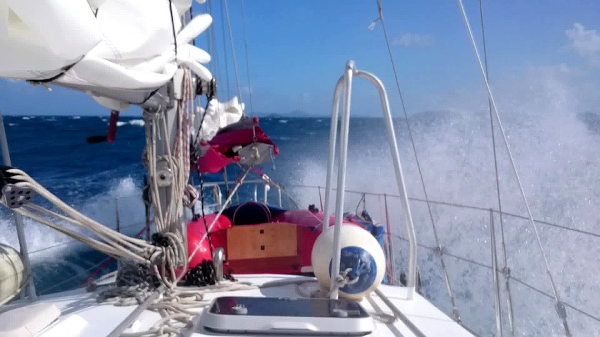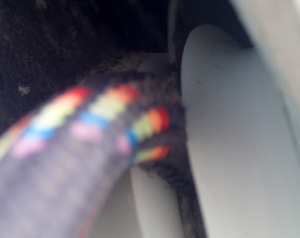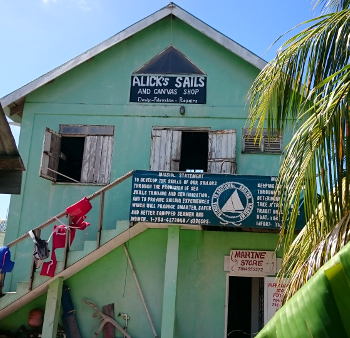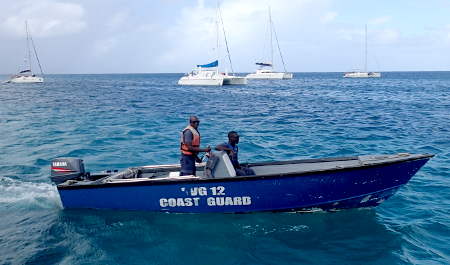This page is an automated translation of /nl/bequia.html and is awaiting a manual review.

After spending a week on the beautiful Tobago Cays we lift anchor and set course for Bequia. The stretch to Bequia is known for being tough, because we have to go to the North-North East, while the wind here usually, as is the case now, comes from the East-North East. It is close to the wind and the waves are steep, high and come from the front. The sailing is spectacular: the boat rams through the waves with great force, occasionally rears against the waves and then falls back into the water with an enormous thump, splashing the water high and spraying all over the boat. We try to sail as tight as possible into the wind, but we just don't manage to catch Bequia in a single stroke. We decide to turn on the engine for the last few miles in a luxurious way and just walk straight into the wind in Bequia.
When we want to lower the sails a nightmare comes out: The mainsail will not go down! The mainsail halyard is firmly fixed at the top of the mast. And that while, precisely to prevent this, we had preventively replaced the discs in the mast on Tenerife and put a thicker fall over it! How is this possible now?
The strong headwind, the steep waves, the counter current and the hoisted sail make it difficult to move forward and for a moment we think that we now also have an engine problem or that there is something wrong with the propeller. Frans puts on his goggles and checks the propeller, there is nothing wrong with that and we are not dragging a large net or something. Because our progress is so bad and because we don't like the idea of having to anchor with a hoisted mainsail - in a bay that is known for very strong downpours - we think the mainsail should be lowered. We call on our friends from the TiSento who had already left for Bequia earlier this week and they tell us that at the anchorage of Bequia there is indeed a lot of wind and that it is quite busy. Not really very suitable for an anchor maneuver with a raised mainsail.

The mainsail just has to go down, willingly or unwillingly. I pull a rope through one of the eyes of the mainsail's sails and put it on a winch. The sail seems to come down slightly but immediately afterwards I hear a tearing sound and tears the eye. That had to be added, a tear in the brand new sail! Ilona considers entering the mast and cutting the halyard, allowing the sail to fall freely. The waves are still steep and high, and just going up the ferociously swinging mast is not an option. Securing Ilona with the help of a loop around the mast is also not possible because the sail is in the way. We decide to attach Ilona's lifting pants with an extra line to the boom lift of the headsail so that her position in relation to the mast is fixed. This is how it should work, and fortunately it doesn't have to be that high because the mainsail is double reefed. I bring the boat to a course and speed where the boat's movement is the least violent and hoist Ilona into the mast. The operation succeeds and after a few strokes with the knife the mainsail falls down. The stabilizing effect of the mainsail is now unfortunately gone, which means that the boat and mast now swing back and forth much more violently. The whole heroic procedure gives Ilona some bruises because of this, but in any case the situation is now under control. Fortunately, things are going well and we anchor safely in the Admirality bay of Bequia.


The next day we want to investigate the problem and plan to hoist Ilona up the mast armed with camera and tools. We want to use the breeding trap for this, but a little later it turns out that it is now suddenly stuck! It is unbelievable but Ilona now has to go up with the spinaker trap. She is unable to get the two stuck traps free, but she can take pictures. The mainsail halyard indeed shows that our suspicion is correct that the line has fallen off the reel and got stuck next to the reel, but in the jib haly nothing is actually visible. We decide that it is better to seek professional help because the problem must be solved properly. We never want a stuck trap again.
Bequia is a nice island. The anchorage is cozy and forms a small self-contained community. Every morning there is a radio on the VHF radio on which newcomers can introduce themselves, the latest news is exchanged, the weather forecast is shared and local service providers can offer their services. We do not register but listen quietly, because we still have to think about what we think of this group event. The contrast with the Tobago Cays is great. There are water taxis for transport, companies that pick up your laundry by boat and return it clean and ironed later, and so on. We are not really into the mass and group events, but hey, it is almost Christmas and that is still a party that you do not celebrate on your own. For a while we have to be a bit of the herd animal.

The village is cheerfully decorated, but the Christmas atmosphere is hard for us to understand, because hanging around on the beach in a sweltering heat is something that we find difficult to associate with Christmas. In what has to pass for a supermarket here, they get up at 30 degrees with Santa Claus hats, it remains a somewhat strange sight. Fortunately, the reindeer and artificial snow are missing here, because that would really be too bizarre. A number of boats (especially American ones) have hoisted lavish lighting in the mast.
We find a sailmaker (Alick) who can repair our torn mainsail and immediately repair the broken zipper of the lazybag of the headsail. We are so satisfied with his fast, good and affordable work that we also have him make a new sprayhood. The good man will continue to work on that during Christmas!
We are less satisfied with the "rigger", the man who does the work in the mast here. He only gets the halyard off the mainsail, but he leaves the most important diagnosis and repair of the underlying problem. And he certainly does not know what to do with the breeding trap.

Bad luck never comes alone. The wind is blowing hard here in Bequia and from our anchorage we depend on our dinghy to get from the boat to shore. Normally we moor our dinghy with a rope and a steel cable with lock, but because we think we will leave an hour later we tie the dinghy to our boat with only the rope. The leaving is canceled, however, so when it gets dark I realize that the dinghy still has to be secured with the steel cable. Because I'm still busy with a job I postpone it for half an hour and that will be fatal ... All I find half an hour later is a worn rope and the dinghy is nowhere to be seen!
We call a water taxi on the VHF and explain the problem. In the dark we sail in the supposed direction in which our dinghy has drifted, but after an hour of searching we have to give up. The owner of the water taxi does not need to have any money, but of course we pay her more than just the gasoline. The local coast guard offers to search for the dinghy at sunrise, there is a chance it ended up in a bay a few miles away. Unfortunately, this search also turns out to be unsuccessful in which the dinghy plus outboard motor must be officially considered lost. The loss of the dinghy is discussed on the radio, but here too no one has seen our dinghy ...

We happened to have agreed with our sailmaker Alick that he would also make a new sprayhood, but for that he had to measure and fit several times. And our anchorage was too far away as far as he was concerned, so we were allowed to touch his mooring. That mooring is at the very front of the village, so that worked out well. Only his own sailboat is still moored, but according to Alick two boats can be moored at the same time. And that turns out to be fine! That way we no longer have to swim that far to go to shore!
Bas and Agnes of the TiSento are very fond of borrowing us a spare thing without a motor. Now we don't even have to swim anymore, we can row!
To our surprise, we also meet acquaintances: The guys from the Zeebink ("Hey, we thought you were going elsewhere!") And the Canadian family we chatted with so much on the beach on Tobago Cays also arrived at Bequia. The Canadians propose to celebrate Christmas Eve together. We think that would be nice and we accept the proposal after which we have a very nice dinner on their catamaran. In most countries, Christmas Eve is THE night of the Christmas dinner, Christmas Day is not that important and Boxing Day is almost unknown.
After the Christmas dinner we get dropped off on the beach to walk to the jetty of our loan dinghy. On the way we arrive at the restaurant in the harbor, where the Christmas dinner has now ended but a steel band is still busy making music in a Caribbean way. There we get to know Melike and Nejat (SY North), a Turkish couple with whom we immediately click. The party is over but a local boy says we can walk with him; further down in the village there is a nice party in the street. He's right, nice music is played. It is busy with mainly locals but also a few tourists. The streets are long enough and give plenty of space, everyone is dancing and having fun. It is getting late, and the next day, Christmas Day, we spend on the beach and at the end of the day we have dinner with Nejat and Melike at a local restaurant.


After Christmas we have to wait until our new sprayhood is ready and in the meantime we are considering the steps to be taken. In Bequia they don't have any dinghies for sale, there is no one who can repair the mast, in short, we have no business here anymore. The nearest place where there are really good facilities is on the island of Martinique, 100 miles to the north. Too much to sail in a daylight period, but St. Lucia is fairly in the middle and just 60 miles away is just feasible if we continue sailing.
Coincidentally, Melike and Nejat are also going to St. Lucia so we decide to leave at the same time. Well, we are an hour earlier because they have a faster boat than us. But you will just see that, just when we want to leave we get a tropical rain shower over us with many gusts of wind (while we are tight between many other boats that are now blowing in all directions) and oil is leaking somewhere near the gearbox, which we of course also want to investigate first. The latter is strong again: To be able to detect oil loss I had built in an oil pressure sensor, but now this brand new oil pressure sensor appears to be leaking oil itself! Fortunately I still had the original blind plug so now the exit oil pressure sensor and the plug had been replaced and the problem was solved.
In the end we have an hour delay and yet we leave simultaneously with Melike and Nejat on our way to St. Lucia.